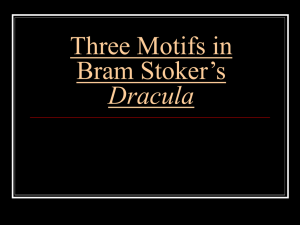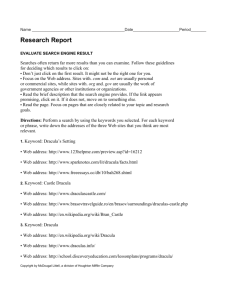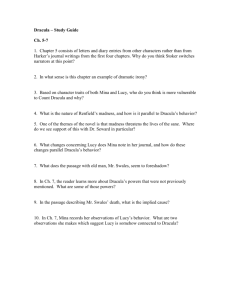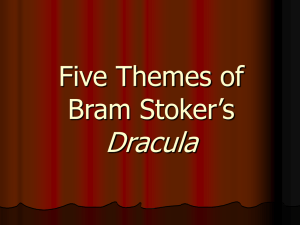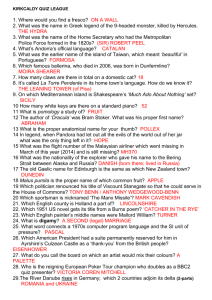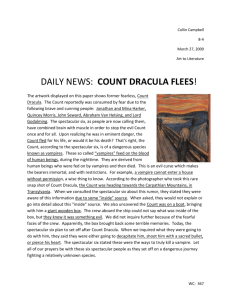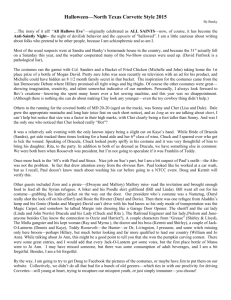could revise the Deane script for an American audience - king
advertisement
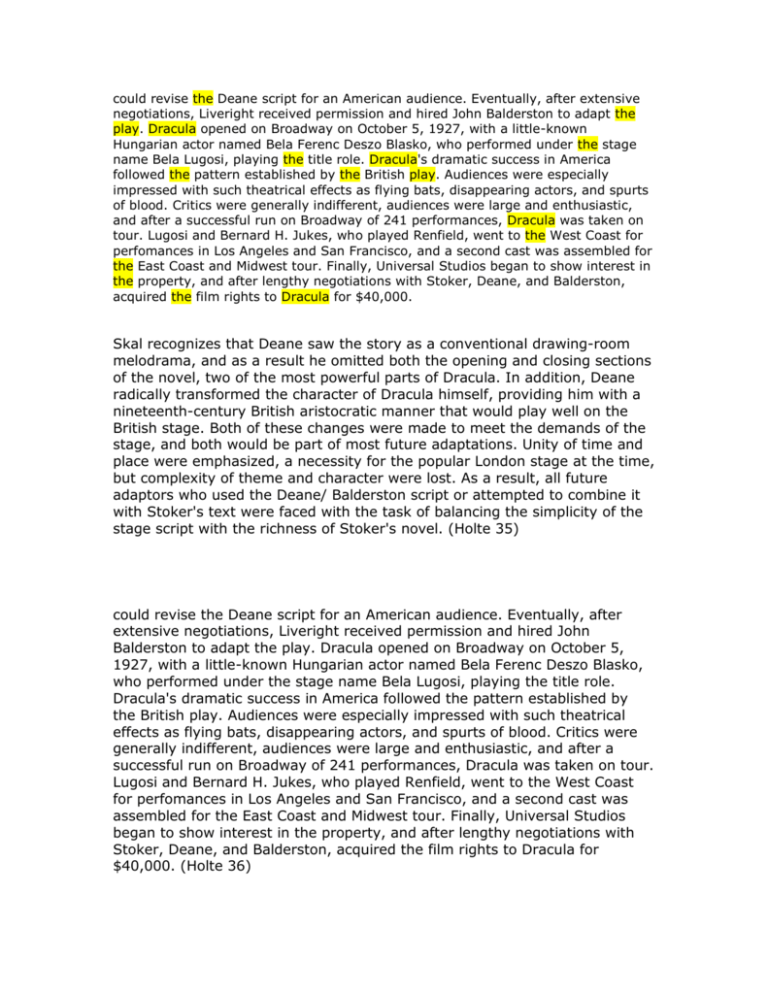
could revise the Deane script for an American audience. Eventually, after extensive negotiations, Liveright received permission and hired John Balderston to adapt the play. Dracula opened on Broadway on October 5, 1927, with a little-known Hungarian actor named Bela Ferenc Deszo Blasko, who performed under the stage name Bela Lugosi, playing the title role. Dracula's dramatic success in America followed the pattern established by the British play. Audiences were especially impressed with such theatrical effects as flying bats, disappearing actors, and spurts of blood. Critics were generally indifferent, audiences were large and enthusiastic, and after a successful run on Broadway of 241 performances, Dracula was taken on tour. Lugosi and Bernard H. Jukes, who played Renfield, went to the West Coast for perfomances in Los Angeles and San Francisco, and a second cast was assembled for the East Coast and Midwest tour. Finally, Universal Studios began to show interest in the property, and after lengthy negotiations with Stoker, Deane, and Balderston, acquired the film rights to Dracula for $40,000. Skal recognizes that Deane saw the story as a conventional drawing-room melodrama, and as a result he omitted both the opening and closing sections of the novel, two of the most powerful parts of Dracula. In addition, Deane radically transformed the character of Dracula himself, providing him with a nineteenth-century British aristocratic manner that would play well on the British stage. Both of these changes were made to meet the demands of the stage, and both would be part of most future adaptations. Unity of time and place were emphasized, a necessity for the popular London stage at the time, but complexity of theme and character were lost. As a result, all future adaptors who used the Deane/ Balderston script or attempted to combine it with Stoker's text were faced with the task of balancing the simplicity of the stage script with the richness of Stoker's novel. (Holte 35) could revise the Deane script for an American audience. Eventually, after extensive negotiations, Liveright received permission and hired John Balderston to adapt the play. Dracula opened on Broadway on October 5, 1927, with a little-known Hungarian actor named Bela Ferenc Deszo Blasko, who performed under the stage name Bela Lugosi, playing the title role. Dracula's dramatic success in America followed the pattern established by the British play. Audiences were especially impressed with such theatrical effects as flying bats, disappearing actors, and spurts of blood. Critics were generally indifferent, audiences were large and enthusiastic, and after a successful run on Broadway of 241 performances, Dracula was taken on tour. Lugosi and Bernard H. Jukes, who played Renfield, went to the West Coast for perfomances in Los Angeles and San Francisco, and a second cast was assembled for the East Coast and Midwest tour. Finally, Universal Studios began to show interest in the property, and after lengthy negotiations with Stoker, Deane, and Balderston, acquired the film rights to Dracula for $40,000. (Holte 36) Works Cited Holte, James Craig. Dracula in the Dark: The Dracula Film Adaptations. Westport, CT: Greenwood Press, 1997. Questia. 12 July 2009 <http://www.questia.com/PM.qst?a=o&d=27547701>. Clerks and greengrocers, artists and landladies could figure in farce, perhaps, and even humbler folk would provide the "comic relief" in melodrama. But, except for such minor characters as domestic servants, they were generally impermissible in drawingroom comedy. A snobbish view, perhaps, snobbish of the playwright as of the actor-manager, but snobbish also of the playgoer, whether from Mayfair or Muswell Hill, who preferred things that way. Snobbishness, or so it seems to us now, prevailed in those days among the educated and semi-educated public. The City clerk, the ill-paid shopassistant, clung to their top hats and starched cuffs -- or at least their employers compelled them to, and though they might have bettered their lot by joining a trade union, they would have scorned to lose respectability by so doing. Humble suburbanites tried desperately to keep up appearances by keeping a "slavey". Only the most reckless and defiant of clerks would have smoked a pipe in the street. No woman with the slightest regard for respectability would have powdered her nose in bus or teashop. Such things were not done. Oh yes, it was an era of snobbishness, and what wonder that this outlook was reflected in the drama? (Wilson 15) Works Cited Wilson, A. E. Edwardian Theatre. London: Arthur Barker, 1951. Questia. 12 July 2009 <http://www.questia.com/PM.qst?a=o&d=6703772>. The purpose of this book is to develop a theory of horror, which is conceived to be a genre that crosses numerous artforms and media. The type of horror to be explored here is that associated with reading something like Mary Shelley's Frankenstein, Algernon Blackwood's “Ancient Sorceries, ” Robert Louis Stevenson's The Strange Case of Dr. Jekyll and Mr. Hyde, H.P. Lovecraft's “The Dunwich Horror, ” Stephen King's Pet Sematary, or Clive Barker's Damnation Game; and it is also associated with seeing something like the Hamilton Deane and John Balderston stage version of Dracula, (Carroll 12) art-horrified by some monster X, say Dracula, if and only if 1) I am in some state of abnormal, physically felt agitation (shuddering, tingling, screaming, etc.) which 2) has been caused by a) the thought: that Dracula is a possible being; and by the evaluative thoughts: that b) said Dracula has the property of being physically (and perhaps morally and socially) threatening in the ways portrayed in the fiction and that c) said Dracula has the property of being impure, where 3) such thoughts are usually accompanied by the desire to avoid the touch of things like Dracula. 25 Of course, “Dracula, ” here, is merely a heuristic device. Any old monster X can be plugged into the formula. Moreover, in order to forestall charges of circularity, let me note that, for our purposes, “monster” refers to any being not believed to exist now according to contemporary science. (Carroll 27) This sort of complex discovery plot-comprising onset, discovery, confirmation, and confrontation-is exemplified in innumerable horror stories of all sorts. Another very well-known example of it can be found in the widely used theatrical popularization of Dracula, adapted by Hamilton Deane and John Baldston. The onset of the vampire is signaled in the opening scene of the first act, where we learn that Lucy has been stricken by the same mysterious disease that has recently killed Mina. Medical science is stymied and Dr. Seward, Lucy's father, has called his old colleague, Professor Van Helsing, onto the case. Van Helsing is the quintessential discoverer figure. Though it appears that he already comes to England suspecting that the problem is a vampire, he sets about piecing together the evidence to support his view and, of course, (Carroll 106) he has to identify the vampire. Initially, he thinks that it must be an Englishman (since vampires must sleep in their native soil), but eventually he discovers that it is Count Dracula. Dr. Seward resists the idea of vampires as unscientific, but Van Helsing and Harker, Lucy's lover, argue the case in a drama of proof that shows how the vampire hypothesis is irresistible. The process of confirmation is nowise as sustained as in The Exorcist, and by the second act Seward seems converted. The play then turns to a series of confrontations, culminating in the staking of Dracula in the secret passage between Seward's asylum and Carfax Abbey. 8 Moreover, a given scene may only incompletely answer a reigning question; in the stage adaptation of Dracula cited earlier, Van Helsing at one point concludes that a vampire is at large, but he doesn't know who it is; that question remains to be answered in an later development. And finally, some scenes or events in popular fictions answer one question, only to introduce one or more other questions; e.g., we know that there is a ravening alien in our outpost, but this leads us to ask what it is, and whether and how we can kill it. Answering such questions could dominate the rest of the plot. These basic erotetic plot functions yield a picture of the narrative skeleton of a great many popular fictions. Whether a scene or an event in a popular narrative is part of the core of the plot depends upon whether it is part of the circuit of questions and answers-including sustaining questions, incomplete answers, simple questions, and simple answers, or combined questions and answers-that unify the action in the plot. (Carroll 135) Works Cited Carroll, NoËl. The Philosophy of Horror, Or, Paradoxes of the Heart. New York: Routledge, 1990. Questia. 15 July 2009 <http://www.questia.com/PM.qst?a=o&d=109157887>. In the 19th century "Gothic" melodrama of Germany, the theme of the doppelgänger or double-personality was a popular one. In the plays of Tieck, Werner, Büchner and Grillparzer as well as the tales of E. T. A. Hoffman, there are gruesome, necrophilic episodes of the transmigration of souls from one body to another, vampires, werewolves that combined human souls and animal instincts, and the splitting of the individual into the dual role of the good-and-bad twin brothers. (Sievers 29) "Dracula, which did not reach Broadway until 1927, illustrates the same splitpersonality motive in Gothic melodrama; the monster is one of the "undead" who sleeps by day and walks the earth by night searching for human blood to suck. The heroine believes herself the victim of horrible nightmares until the two red spots on her neck confirm the presence of the vampire. The evil genius by day proves to be the suave Count Dracula who uses hypnosis over his victims to prepare them. (Sievers 30) Sievers, W. David. Freud on Broadway: A History of Psychoanalysis and the American Drama. 1st ed. New York: Hermitage House, 1955. Questia. 15 July 2009 <http://www.questia.com/PM.qst?a=o&d=6539760>. Title: Review: [untitled] Author(s): Chris Ellery Reviewed Title(s): The Gothic Impulse in Contemporary Drama Reviewed Authors(s): Mary Beth Inverso Source: Theatre Journal, Vol. 42, No. 3, Women and/in Drama (Oct., 1990), pp. 403-404 Publisher(s): The Johns Hopkins University Press Stable URL: http://www.jstor.org/stable/3208106 Taking Melodrama Seriously: Theatre, and Nineteenth-Century Studies Louis James History Workshop, No. 3 (Spring, 1977), pp. 151-158 Published by: Oxford University Press Browning Dracula has an analogous composite character, though not easily recognized because he is not a physical "double." John Harker, at one end of the pole, is an impotent lover (spiritually as well as physically in his inability to help Mina resist the advances of the Count). In the center is Dr. Van Helsing ( Edward Van Sloan), representing the marriage of occult reasoning with science to aid human understanding, informs his colleagues: "The superstition of yesterday becomes the scientific reality of today." Dracula, at the opposite pole, is the ideal Romantic lover, the man of mystery, the outcast of society, the seer who knows far more than the mortals he encounters and brings life-in-death to all he touches.
